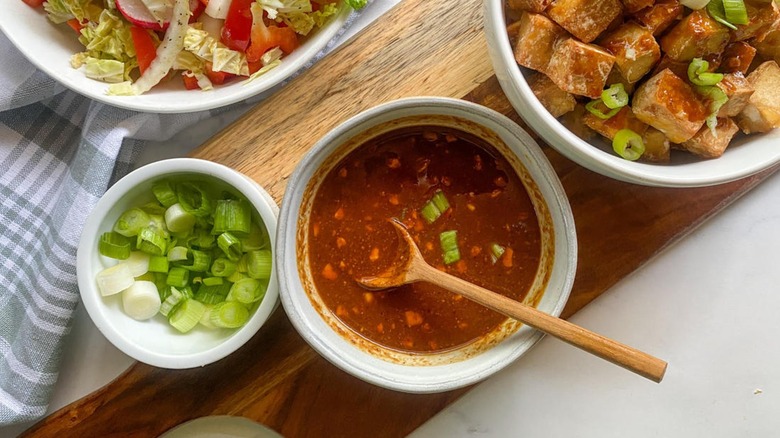Gochujang Is The Key To A Well-Rounded Hoisin Sauce
There are many reasons you might want to make your own condiments — maybe you're trying to save money, or perhaps you're just doing it for fun. One of the best reasons, however, might be the fact that DIY condiments allow you to change up the ingredients to suit your needs and preferences. Mashed recipe developer Miriam Hahn says of her homemade hoisin sauce, "If you want to make this and have a nut allergy, you can easily substitute sunflower seed butter or tahini." You could swap soy sauce for tamari and have a gluten-free alternative. (Well, as long as you've purchased a gluten-free miso variety, that is.) Hahn also changes up the standard hoisin sauce by spicing it up with another condiment.
As Hahn tells us, at the time she created her homemade hoisin recipe, she "ha[d] been on a gochujang kick" and was adding the sauce to all manner of things. She describes it as tasting both sweet and salty with some of the same umami flavor that you get from miso paste. She cautions against adding too much of the stuff to your sauce, saying, "A little goes a long way." Still, the combination of complementary flavors makes for a spicy hoisin sauce that hits all of the right flavor notes.
Gochujang and hoisin actually have some ingredients in common
One reason why gochujang works so well in Miriam Hahn's homemade hoisin recipe is that while the two sauces are fairly dissimilar on the surface, they do share a few common ingredients. Hoisin sauce, which is also sweet and salty, typically includes chiles, fermented soybean paste, garlic, salt, sesame oil, some kind of sweetener, and vinegar. Gochujang also includes chiles, fermented soybeans, salt, sesame oil, and glutinous rice. It tends to be spicier and not quite as sweet as hoisin, but the fermented soybeans give them a similarly funky flavor.
Both gochujang and hoisin are used in similar ways, as well. Either (or both) can be added to stir-fries and noodle dishes or rubbed over meats before or after cooking. The two sauces can also be used as dips for dumplings or shrimp chips, but both may benefit from being diluted with other ingredients like soy sauce, sesame oil, or rice vinegar since they can be a bit overpowering on their own.

